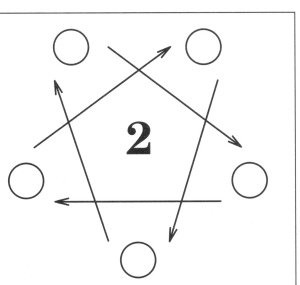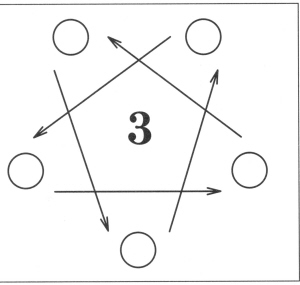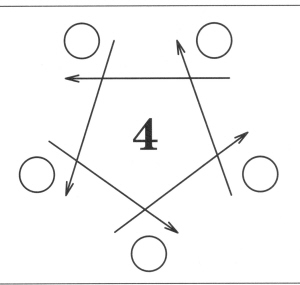| Figure 6.
Everyone's passes in Complete 3-Count Star
|
 |
 |
 |
Page 34 Winter 1994 - 95
|
Of
the four passes in the sequence, the hard ones are the first and last.
The middle two passes are fairly easy because the angles between the
outgoing passes and the incoming passes are relatively small. But the
first and last passes have extreme angles between outgoing and incoming
clubs. You're passing to the person next to you on one side and catching
from the person next to you on the other side.
On
the first beat, each of you passes right handed to the person on your
left (see beat 1 in Fig. 6). You should turn at least a little to the
left so you can see where you're passing, which is to the far side of
the person on your left. The pass should go about a foot outside the
left shoulder, getting there at shoulder height. Make sure it gets all
the way to that point on the person's left - if it gets only to the
middle of body, it will force the catcher to turn towards you, which
will make throwing the next pass hard. The club should of course pass
far enough in front of the receiver to
Note
that as soon as you've made the first pass, to the person on your left,
you need to quickly look for the club coming
On
the second passing beat, you pass left handed to the second person on
your left (as you progress around the circle clockwise). This pass is
fairly easy. After you make it, look towards the next person to the
right for the club coming in to your right hand. The
third passing beat is slightly easier yet, because you pass the club
that you just received with your right hand back where it came from - to
the second person on your right.
The
fourth and final pass in the sequence is another tricky one along the
rim of the pentagon, this time from your left hand to the far (right)
side of the person on your right. This is the mirror image of the first
pass, so the same suggestions apply. Make sure the pass isn't short or
inside. And after. you make the pass, quickly look to your extreme left
for the club coming to your right hand. Then do the requisite two selves
and pass that very club back
Since
this is a 3-count, each pass you
catch from someone is the club that you
pass next. In a two-person 3-count, you always throw the passed
club back where it came from. That's true here on two of the four
passing beats. In particular, the clubs that are passed on beats 2 and 4
(both passed left handed) are caught right handed and thrown back to the
original left hands on the following beats (3 and 1, respectively). That
is to say, if you catch a pass in your right hand, you're supposed to
throw it back where it came from.
On
the other hand (pun intended), if you catch a pass in your left hand, you
throw it to the other person who sometimes passes to your left
hand. Thus when you catch left handed from the second person, you throw
the club to the fourth person and vice versa.
While
you're passing to your four partners in clockwise order, you're actually
catching from the same four people in exactly the opposite order,
counterclockwise.
If
you get the Complete 3-Count Star down really smooth, try doing the same
pattern but in a 1-count, with the same four-beat cycle (just omit all
the selves).
|
| Figure 6.
Everyone's passes in Complete 3-Count Star
|
 |
 |
 |